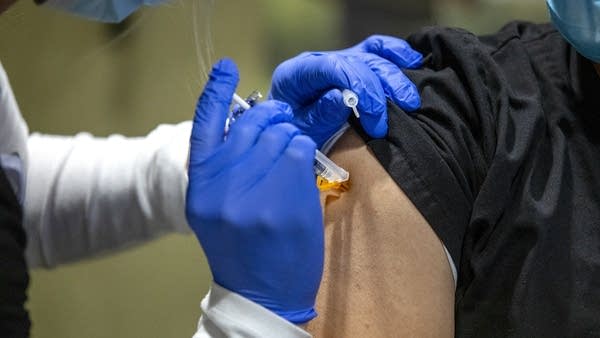Oxygen, iPads and PPE: St. Cloud doctor treating COVID-19 patients recalls year of change

Go Deeper.
Create an account or log in to save stories.
Like this?
Thanks for liking this story! We have added it to a list of your favorite stories.
If someone had asked Dr. Mithun Suresh about COVID-19 last January, he said he probably wouldn't have known what they were talking about.
But these days, he's immersed in the pandemic. It's changed almost every facet of his job, including the ways he interacts with patients and communicates with their loved ones — to the way he and his colleagues treat the coronavirus itself.

"It's been pretty incredible how much things have changed, even in just six to seven months,” Suresh said. “The way we approach these patients now is very different from how we were approaching these patients in March. And that reflects how much we've learned about how to treat patients with this disease."
Central Minnesota, like much of the state, has edged close to crisis several times since the COVID-19 pandemic began, with hospital beds at a premium. Now, the pressure is beginning to ease, though health officials warn the state could swing quickly back into crisis.
Turn Up Your Support
MPR News helps you turn down the noise and build shared understanding. Turn up your support for this public resource and keep trusted journalism accessible to all.
Suresh, 33, has been working in St. Cloud Hospital’s COVID-19 unit as a hospitalist — a doctor who specializes in treating hospitalized patients. In November and December, COVID-19 cases were spiking statewide. And in Suresh’s unit, as soon as one patient was moved out of a room, another would quickly be moved in.
Some patients were coming in for the first time. Others had gone to an urgent care or ER, felt well enough to go home, but then, their symptoms worsened — so they returned to the hospital, and were admitted.
"When we are discharging patients, it feels good to be able to do that,” he said. “But also, we sometimes cross our fingers and hope that this isn't a patient that a few days later we'll end up seeing back in the hospital because their symptoms may have worsened."
In the past 10 months, Suresh and his colleagues have quickly learned a lot about treating COVID-19. But he said knowledge about the disease is constantly changing. He starts many workdays in a quick huddle with other staff, discussing the latest medical developments.
One thing they've learned is that a patient’s oxygen needs can change dramatically, even overnight. With a disease known to attack the respiratory system, that's one telltale metric Suresh gauges closely as he checks on his patients each morning.
"Sometimes they're on maybe minimal oxygen when you leave for the day,” he said. “And you get back the next morning, they're actually needing quite a bit of oxygen."
That's one of the factors he uses to decide whether a patient is ready to go home, or to a nursing home or rehab facility. Others just need to stay in the hospital longer. That’s difficult news to deliver to both patients and staff, Suresh said.
"It's always disappointing when you have to tell them that they'll need to stay for another day,” he said. “But at the end of the day, the goal is to try to ensure that when they do go home that they're safe, and their risk and the odds of them coming back to the hospital are low."
Before COVID-19, family members were usually right at the patient's bedside, so he could deliver that news in person, along with updates on their prognosis and treatment. Now, due to visitor restrictions, a patient’s loved ones aren’t able to be with them at the hospital, and communication usually happens with a phone call.
"Some of the more difficult conversations in the middle of the night are when unexpected things or challenging things or emergencies happen and you're having to cold call family members to explain that an emergency’s happened,” he said.
Suresh said he's watched health care workers grow more comfortable with responding to the pandemic — from using iPads to help patients talk to their family to putting on personal protective equipment and treating patients.
There are more treatment options now, like Remdesivir and convalescent plasma. But they're not magic bullets, Suresh said, and don't help everyone.
And despite all they've learned, there's still no surefire strategy to predict who's going to recover from this disease, he said. The patients who stick in his memory are those who started with a fairly mild case, then — for whatever reason — got worse.
"For me, those cases stand out,” he said. “Because as health care providers, you ask yourself and you wonder, is there something you could have done to prevent that or is there something you missed?"
Lately, there have been signs of hope. COVID-19 cases at St. Cloud Hospital have fallen significantly since the fall peak. Suresh and other health care workers recently received the first dose of vaccine.
And despite the challenges of the past year, Suresh says it's reaffirmed how gratifying it can be to work with a team of hospital colleagues, and see someone who's sick get better.
“We’ve been able — as physicians, nurses, respiratory therapists and others … to really participate firsthand in the care of some of these patients, many of whom have been very sick,” he said. “That’s been a very rewarding aspect of this pandemic.”
COVID-19 in Minnesota
Data in these graphs are based on the Minnesota Department of Health's cumulative totals released at 11 a.m. daily. You can find more detailed statistics on COVID-19 at the Health Department website.
The coronavirus is transmitted through respiratory droplets, coughs and sneezes, similar to the way the flu can spread.


